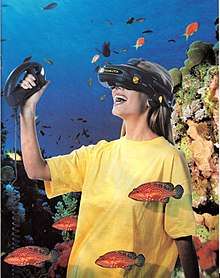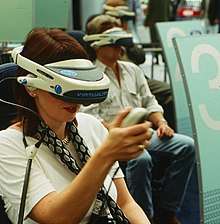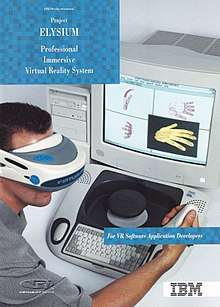Virtuality (product)
Virtuality is a line of virtual reality gaming machines produced by Virtuality Group, and found in video arcades in the early 1990s.[1] The machines deliver real time (less than 50ms latency) gaming via a stereoscopic visor, joysticks, and networked units for multi-player gaming.


Following Dr. Jonathan D Waldern's VR PhD research (1985–1990) and [2] supported by IBM Research Labs, Virtuality Group was formed in 1985 as a startup called W Industries.[3] Waldern's company developed many of the principal components including VR headsets, graphics subsystems, 3D trackers, exoskeleton data gloves and other enclosure designs. Fully developed by 1990, the VR integrated systems were launched at a computer graphics show at crystal palace and marketed to industry. The first two networked VR systems were sold to British Telecom Research Laboratories to experiment with networked telepresence applications. Many other systems were sold to corporations including Ford, IBM, Mitsubishi and Olin. Professional virtual reality systems included: a virtual reality attraction created by Creative Agency Imagination for the launch of the 1995 Ford Galaxy and a virtual trading floor for the London International Financial Futures and Options Exchange (LIFFE).[4]
There are two types of units (referred to by the company as "pods"): One where the player stands up (SU), and the other where they sit down (SD). Both unit types utilize virtual reality headsets (the "Visette") which each contain two LCD screens at resolutions of 276x372 each. Four speakers and a microphone were also built into the unit.[5] The SU units have a Polhemus 'Fast Track' magnetic source built into the waist high ring with a receiver in a free-moving joystick (the "Space Joystick"), while the SD design has the player sitting down with joysticks, a steering wheel, or aircraft yoke for control, depending on the game. The SD system was developed and launched in 1993 at Wembley Stadium in London.
Using the magnetic tracking system the stereoscopic display was able to react to head movements to change the display based on what the player would be "looking at" within the gaming environment. The position of the joystick (also magnetically tracked) controls movement of the player's "virtual hand", and a button on the joystick moves the player forwards in the game arena.
1000 Series
Introduced in October 1991,[6] and powered by an Amiga 3000,[6] the 1000CS and 1000SD have a distinctive helmet comprising a brightly coloured front panel with 'VIRTUALITY' embossed across it.
1000CS games
- Dactyl Nightmare – Multiplayer map with several levels and platforms; grenade launcher weapons and pterodactyl enemy.
- Grid Busters – Robot shoot-em-up.
- Hero – Locked door puzzle.
- Legend Quest – Fantasy adventure.
1000SD games
- Battlesphere – Space battle.
- Exorex – Robot warriors.
- Total Destruction – Stock car racing.
- VTOL – A Harrier Jump Jet simulator.
- Flying Aces – A biplane dogfight simulator.
Virtuality's release surprised the existing VR industry. Despite crude graphics, it offered what Computer Gaming World in 1992 described as "all the necessary hallmarks of a fully immersive system at what, to many, is a cheap price. The main complaint ... has so far been its lack of resolution and software support".[7]
2000 Series
The 2000SU and SD models were introduced in 1994,[8] powered by an Intel 486-PC and using Motorola 88110 processors for graphics rendering.[9] They have several more games including Buggy Ball, Dactyl Nightmare 2 - Race For The Eggs!, Zone Hunter[10][11] and Pac-Man VR.
There was also a 3000 series, which was basically a 2000 Series machine upgraded with faster processor (Intel Pentium) and a rifle-type controller. They were offered in 2 versions, a "normal" SU-3000 with a generic rifle-type controller and a "Total Recoil" version with an official Winchester Replica Rifle-type controller that featured a CO
2-powered blowback mechanism.[12] The "Total recoil" Version came with the game package "Quickshot Carnival" which featured Clay shooting and other target practice.[13] The "normal" generic-rifle version came with the game "Zero Hour", which was a first-person shooter "on rails" that was tailor-made for the gun controller.
Project Elysium

Virtuality also worked to use their VR technology for more practical purposes. Project Elysium was a virtual reality system developed in 1995 by Virtuality for IBM for use in architectural and construction applications to give builders and clients an idea of how things would look once they were built, among other uses.[14][15] It was a "complete integrated VR workstation with development software" and it included a visette and hand-held control device called the "V-Flexor. It has created a high way gaming."[16][17]
Company
Developer W. Industries (named after its founder Dr. Jonathan D. Waldern), later renamed Virtuality Group Plc, was founded in 1987.[18] The company was backed by Lord Wolfson of Wembly Group Plc, who with Apax Venture Capital company were majority shareholders. There were five group subsidiaries. In 1997, rights to the entertainment machines (but not the Virtuality brand) were sold to CyberMind UK in a breakup of the group owing to a dramatic slump in demand for the expensive (then $65,000) theme park and Arcade machines, causing the manufacturing division (called Virtuality Entertainment) insolvency. Thereafter CyberMind UK was sold to Arcadian Virtual Reality LLC in 2004. In Australia, Fun City Entertainment Complex in Sunshine, Melbourne Victoria is the only venue in Australia running the SU 2000 models and is an agent for the sale and support of the Virtuality entertainment systems. During the company sale, Dr Waldern purchased all IP consumer technology rights, in addition to all Virtuality brand rights other than entertainment machines. In 1996 he launched a consumer VR display in partnership with Takara,[18] and another in 1998 with Philips Electronics (under the brand name "Scuba"). Combined, over 55,000 headsets were sold, mostly in Japan.
The company is currently working on next generation optoelectronics technology and applications including applications for Virtual Reality.
References
- Horsman, Matthew (March 17, 1995). "Virtuality Ties up Atari Deal". The Independent. Retrieved 10 February 2016.
- DigiLens Inc. "Waldern Virtuality" – via YouTube.
- Davies, Hunter (November 22, 1993). "The Hunter Davies Interview: Dr Waldern's Dream Machines". The Independent. Retrieved 10 February 2016.
- "Archived copy". Archived from the original on 2012-10-11. Retrieved 2012-08-20.CS1 maint: archived copy as title (link)
- "Human Interface Technology Lab". washington.edu.
- "Amiga History Guide". www.amigahistory.co.uk.
- Engler, Craig E. (November 1992). "Affordable VR by 1994". Computer Gaming World. p. 80. Retrieved 4 July 2014.
- Webb, Marcus (March 1995). "Arcadia". Next Generation. Imagine Media (3): 31.
- SU2000 Technical Manual
- "Zone Hunter arcade video game by Virtuality (1994)". www.arcade-history.com.
- "Zone Hunter". Next Generation. Imagine Media (10): 130. October 1995.
- Webb, Marcus (February 1996). "Arcadia". Next Generation. No. 14. Imagine Media. p. 29.
Three target shooting games are available for its new 'Total Recoil' system, which features a realistic Model 101 shotgun from the Winchester rifle company. The pneumatic gun gives a real, physical kickback when you fire it.
- Hidden Below. "Virtuality Quickshot Carnival RM footage" – via YouTube.
- Camara, Antonio, and Raper, Jonathan. "Spatial Multimedia and Virtual Reality". CRC Press, 1999. p. 133.
- DYE, LEE (22 February 1995). "Technology is finding important places in medicine, engineering and many other realms" – via LA Times.
- Craig, Sherman, and Will. "Developing Virtual Reality Applications: Foundations of Effective Design". Morgan Kaufmann (publisher), 2009, p. 326.
- commons:File:Project Elysium pg 3.jpg
- "Takara and Virtuality Head Homeward". Next Generation. No. 19. Imagine Media. July 1996. p. 24.
External links
- Owner of Virtuality Brand, Technology and new Product Development
- Virtuality (Internet Archive)
- Arcadian Virtual Reality LLC—the current owner of Virtuality SU, SD & CS Arcade Machines
- Arcade History—where all the above games can be found
- Cybermind—Overview of the different systems
- Reality Crumbles: Whatever happened to VR?
- The Story of Virtuality (YouTube)